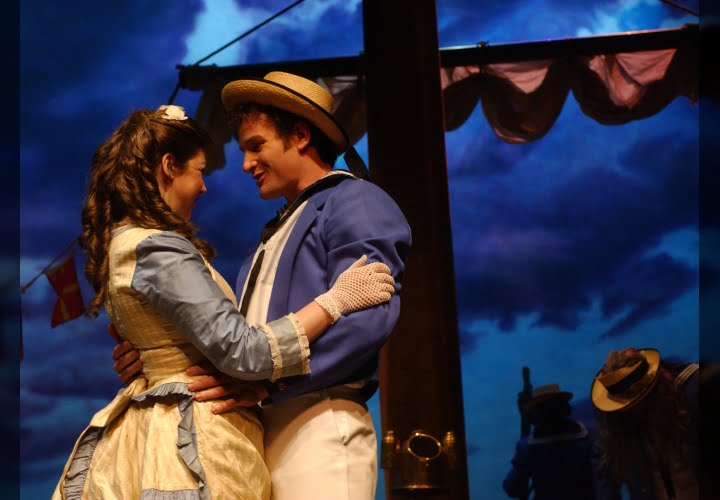Name: HMS Pinafore
Written by: Gilbert (libretto) and Sullivan (music)
Premiere: 25 May 1878 at the Opera Comique, London
Language: English
List of characters
The Rt Hon Sir Joseph Porter, KCB: First Lord of the Admiralty, comic baritone
Captain Corcoran: commander of the Pinafore, lyric baritone
Ralph Rackstraw: able seaman, tenor
Dick Deadeye: able seaman, bass-baritone
Bill Bobstay: Boatswain’s mate, baritone
Bob Becket: Carpenter’s mate, bass
Josephine: the Captain’s daughter, soprano
Cousin Hebe: Sir Joseph’s first cousin, mezzo-soprano
Mrs Cripps (Little Buttercup): a Portsmouth bumboat woman, contralto
Chorus of the First Lord’s sisters, his cousins, his aunts, sailors, marines and so on
Musical numbers
Overture
Act I
‘We sail the ocean blue’ (sailors)
‘Hail! men-o’-war’s men … I’m called Little Buttercup’ (Buttercup)
‘But tell me who’s the youth’ (Buttercup and Boatswain)
‘The nightingale’ (Ralph and chorus of sailors)
‘A maiden fair to see’ (Ralph and chorus of sailors)
‘My gallant crew, good morning … I am the captain of the Pinafore’ (Captain and chorus of sailors)
‘Sir, you are sad’ (Buttercup and Captain)
‘Sorry her lot who loves too well’ (Josephine)
‘Reflect, my child’ (Captain and Josephine)
‘Over the bright blue sea’ (chorus of female relatives)
‘Sir Joseph’s barge is seen’ (chorus of sailors and female relatives)
‘Now give three cheers … I am the monarch of the sea’ (Captain, Sir Joseph, Cousin Hebe and chorus)
‘When I was a lad’ (Sir Joseph and chorus)
‘For I hold that on the sea’ (Sir Joseph, Cousin Hebe and chorus)
‘A British tar’ (Ralph, Boatswain, Carpenter’s mate and chorus of sailors)
‘Refrain, audacious tar’ (Josephine and Ralph)
‘Can I survive this overbearing?’ (ensemble)
‘Oh joy, oh rapture unforeseen’ (ensemble)
‘Let’s give three cheers for the sailor’s bride’ (ensemble)
‘A British tar’ (reprise; ensemble)
Act II
‘Fair moon, to thee I sing’ (Captain)
‘Things are seldom what they seem’ (Buttercup and Captain)
‘The hours creep on apace’ (Josephine)
‘Never mind the why and wherefore’ (Josephine, Captain and Sir Joseph)
‘Kind Captain, I’ve important information’ (Captain and Dick Deadeye)
‘Carefully on tiptoe stealing’ (Soli and chorus)
‘Pretty daughter of mine’ (Captain and ensemble)
‘He is an Englishman’ (Boatswain and ensemble)
‘Farewell, my own’ (Ralph, Josephine, Sir Joseph, Buttercup and chorus)
‘A many years ago’ (Buttercup and chorus)
‘Here, take her, sir’ (Sir Joseph, Josephine, Ralph, Cousin Hebe and chorus)
‘Oh joy, oh rapture unforeseen’ (ensemble)
Story
Also known as The Lass Who Loved a Sailor, this satirical operetta is set aboard the titular ship and revolves around the love between lowly sailor Ralph Rackstraw and Josephine, the captain’s daughter. Her father, Captain Corcoran, forbids the affair because of their very different social standings, hoping instead for a marriage between Josephine and Sir Joseph, the First Lord of the Admiralty. However, a surprise disclosure about Ralph’s true identity changes things dramatically.
Act I
The opera opens with the crew of the HMS Pinafore polishing the brasswork and scrubbing the decks as Little Buttercup arrives with her basket of wares. She is followed by Ralph Rackstaw, who declares his love for Captain Corcoran’s daughter Josephine.
The captain enters to greet his crew; the sailors leave and Corcoran informs Little Buttercup that Sir Joseph, First Lord of the Admiralty, seeks Josephine’s hand in marriage. We’re now introduced to Josephine, who confesses to her father that she is in love with a lowly sailor, but her duty as his daughter means she will never reveal her love to the sailor.
Sir Joseph comes onboard along with several female relatives. He soon shows himself to be pompous with an unshakeable sense of his own superiority, despite being totally unqualified for his position. Josephine is unimpressed, but feels she must marry him. When Ralph tells her his feelings she rejects him. Devastated, he is about to commit suicide only to be stopped by Josephine, who reveals her love and the couple plan to elope.
Act II
The Act opens with Captain Corcoran recounting his concerns about Josephine’s love for someone beneath her social position. Little Buttercup expresses sympathy, but the captain also points out that any relationship between them is also impossible due to his own exalted position. Buttercup darkly hints that a change is in store.
Sir Joseph reappears, complaining that Josephine hasn’t agreed to marry him. Corcoran suggests might be because she feels she is not equal to the First Lord and that Sir Joseph should reassure her that social rank doesn’t matter when two people are in love. This he does, but she thinks this means the love between her and Ralph, strengthening her determination to run away with him. However, Dick Deadeye betrays these plans to the captain and the pair are caught; Ralph is chained and taken to the brig.
But Little Buttercup comes to the rescue – revealing her long-kept secret. Many years before, when she practised baby-farming, she had cared for two babies, one of low birth, the other of much higher standing. However, she mixed the children up, and the well-born infant was Ralph; the other was Captain Corcoran.
And so one of opera’s most remarkable changes of fortunes occurs. Ralph instantly becomes the Pinafore’s captain and Corcoran a sailor. Sir Joseph is no longer interested Josephine, leaving her free to marry Ralph, while Corcoran and Little Buttercup are now also of equal rank, allowing them to marry too. Sir Joseph settles for his cousin Hebe, and it’s a happy ending for all.
Image
Kirk Mariner (Ralph) and Yvonne Gold (Josephine) in HMS Pinafore, directed by Keith Fowler, Virginia Museum Theatre, 1970 (KFOWLER via Wikimedia Commons).

